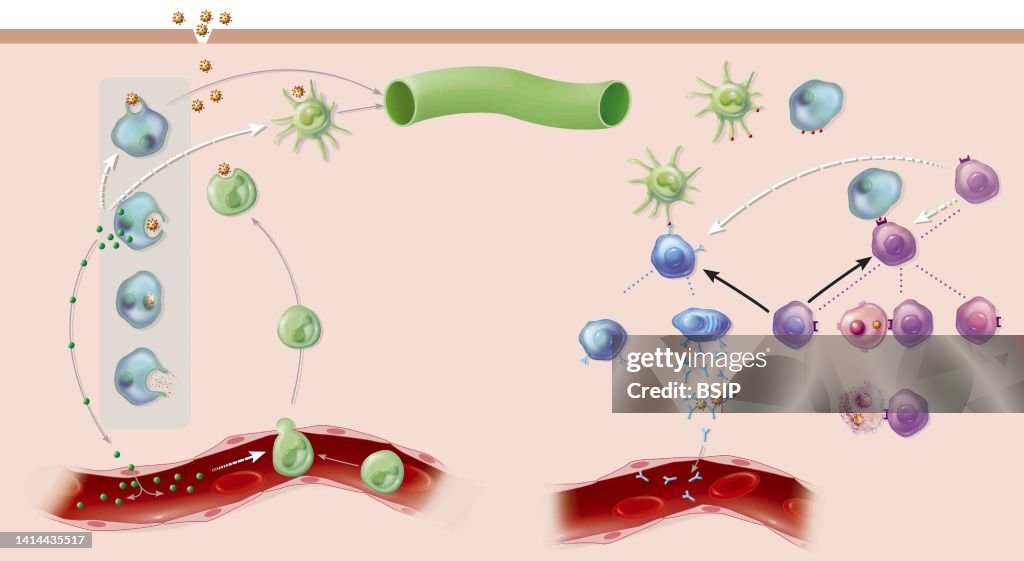Innate immunity - adaptive immunity
Innate immunity and adaptive immunity, the defenses of the immune system. When a micro-organism or microbe (virus, bacterium) penetrates the barriers of the organism (skin, mucous membranes) innate immunity (on the left of the drawing) acts immediately. This first immune reaction stops the progression and development of microbes in the body. Macrophages, dendritic cells and neutrophils are players in innate immunity. Macrophages (in bluish green) destroy microbes by phagocytosis and produce cytokines. These cytokines call on neutrophils (among other things) to also fight against microbes. But these cytokines also drive macrophages and dendritic cells to the lymph nodes (white arrows). If despite everything, the microbes proliferate and spread in the body, adaptive immunity comes into play (on the right of the drawing). Dendritic cells and macrophages present microbe antigens to B (blue) and T (purple) lymphocytes. There are 4 kinds of T lymphocytes. On the one hand, cytotoxic T lymphocytes (killer) kill infected cells (in pink). On the other hand, helper T lymphocytes (helper) stimulate B and T lymphocytes (white arrow). Then the memory T lymphocytes will respond quickly to the next invasion of the same microbe. Whereas regulatory T lymphocytes (bluish violet cell) inhibit B and T cells once the danger has passed (black arrows). B lymphocytes give rise to two types of lymphocytes. Memory B cells respond quickly to future microbial invasion. And plasma cells produce antibodies that attach to microbes. The antibodies are also released into the bloodstream. This allows you to see if the body has been in contact with a microbe through a blood test. So these antibodies will directly neutralize the microbes or mark an infected cell so that it is taken over by other immune cells such as macrophages. (Photo by: JACOPIN/BSIP/Universal Images Group via Getty Images)

PURCHASE A LICENSE
How can I use this image?
€300.00
EUR
Getty ImagesInnate immunity - adaptive immunity, News Photo Innate immunity - adaptive immunity Get premium, high resolution news photos at Getty ImagesProduct #:1414435517
Innate immunity - adaptive immunity Get premium, high resolution news photos at Getty ImagesProduct #:1414435517
 Innate immunity - adaptive immunity Get premium, high resolution news photos at Getty ImagesProduct #:1414435517
Innate immunity - adaptive immunity Get premium, high resolution news photos at Getty ImagesProduct #:1414435517€475€115
Getty Images
In stockPlease note: images depicting historical events may contain themes, or have descriptions, that do not reflect current understanding. They are provided in a historical context. .
DETAILS
Restrictions:
Contact your local office for all commercial or promotional uses.
Credit:
Editorial #:
1414435517
Collection:
Universal Images Group
Date created:
April 17, 2021
Upload date:
License type:
Release info:
Not released.��More information
Source:
Universal Images Group Editorial
Object name:
941_28_bsip_016250_005
Max file size:
5100 x 2792 px (17.00 x 9.31 in) - 300 dpi - 722 KB